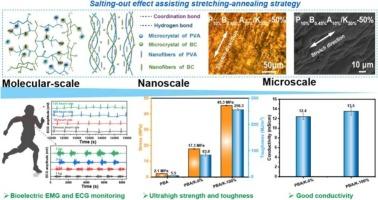Synergistic stretching-annealing and salting-out enabling ultrastrong, ultratough anisotropic bacterial cellulose conductive hydrogels for bioelectric sensors
IF 12.5
1区 化学
Q1 CHEMISTRY, APPLIED
引用次数: 0
Abstract
Developing high-performance hydrogels that simultaneously exhibit biocompatibility, exceptional strength, toughness, conductivity, and antibacterial properties is crucial for meeting the stringent demands of bioelectric signal monitoring. Herein, we present an integrated approach for designing anisotropic bacterial cellulose (BC) hydrogels (PBA/K-a%) involving stretching the as-prepared polyvinyl alcohol (PVA)-BC-2-acrylamido-2-methylpropanesulfonic acid (AMPS) hydrogels (PBA) to various elongation ratios (a%), followed by air-drying during annealing to align the polymer chains, and finally immersed in potassium citrate (K3Cit) solutions to enhance the polymeric interactions via a synergistic stretching-annealing and salting-out (SSAS) strategy. This effective strategy improves molecular hydrogen and coordination interactions, enhances crystallinity, and induces the orientation of polymer chains and nanofibers along the stretching direction, significantly increasing the mechanical robustness of the hydrogels. Notably, the P10%B0.45%A10%/K-100 % hydrogel demonstrates ultrahigh mechanical strength of 45.32 MPa, high strain of 838 %, and ultrahigh toughness of 256.26 MJ/m3, as well as good conductivity with 13.3 mS/cm. The cooperative incorporation of PAMPS and K3Cit endows the hydrogel with good antibacterial capacity, establishing it as a unique and effective wearable sensor. Furthermore, the PBA/K-100 % hydrogel was successfully employed for the bioelectric signal monitoring of electrocardiograms (ECG) and electromyograms (EMG), thus demonstrating its potential applications in human-machine interactions and bioelectronics.

协同拉伸退火和盐析使生物电传感器的超强、超韧各向异性细菌纤维素导电水凝胶
开发同时具有生物相容性、超强强度、韧性、导电性和抗菌性能的高性能水凝胶对于满足生物电信号监测的严格要求至关重要。在此,我们提出了一种设计各向异性细菌纤维素(BC)水凝胶(PBA/K-a%)的综合方法,包括将制备的聚乙烯醇(PVA)-BC-2-丙烯酰胺-2-甲基丙磺酸(AMPS)水凝胶(PBA)拉伸到不同的延伸率(a%),然后在退火过程中进行风干以排列聚合物链。最后浸泡在柠檬酸钾(K3Cit)溶液中,通过拉伸-退火和盐析(SSAS)协同策略增强聚合物相互作用。这种有效的策略改善了分子氢和配位相互作用,提高了结晶度,并诱导聚合物链和纳米纤维沿拉伸方向取向,显著提高了水凝胶的机械鲁棒性。值得注意的是,P10%B0.45%A10%/ k - 100%水凝胶具有45.32 MPa的超高机械强度、838%的高应变、256.26 MJ/m3的超高韧性和13.3 mS/cm的良好电导率。PAMPS与K3Cit的协同结合,赋予了水凝胶良好的抗菌能力,使其成为一种独特而有效的可穿戴传感器。此外,PBA/ k - 100%水凝胶已成功用于生物电信号监测心电图(ECG)和肌电图(EMG),从而展示了其在人机交互和生物电子学方面的潜在应用。
本文章由计算机程序翻译,如有差异,请以英文原文为准。
求助全文
约1分钟内获得全文
求助全文
来源期刊

Carbohydrate Polymers
化学-高分子科学
CiteScore
22.40
自引率
8.00%
发文量
1286
审稿时长
47 days
期刊介绍:
Carbohydrate Polymers stands as a prominent journal in the glycoscience field, dedicated to exploring and harnessing the potential of polysaccharides with applications spanning bioenergy, bioplastics, biomaterials, biorefining, chemistry, drug delivery, food, health, nanotechnology, packaging, paper, pharmaceuticals, medicine, oil recovery, textiles, tissue engineering, wood, and various aspects of glycoscience.
The journal emphasizes the central role of well-characterized carbohydrate polymers, highlighting their significance as the primary focus rather than a peripheral topic. Each paper must prominently feature at least one named carbohydrate polymer, evident in both citation and title, with a commitment to innovative research that advances scientific knowledge.
 求助内容:
求助内容: 应助结果提醒方式:
应助结果提醒方式:


